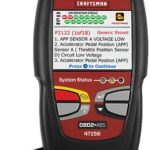Understanding your vehicle’s On-Board Diagnostics (OBD) system, specifically OBD2, is crucial for maintaining its health and performance. This comprehensive guide delves into the history, functionality, and future of OBD2, explaining how it empowers vehicle owners and fleet managers with valuable insights.
What is OBD2 (On-Board Diagnostics II)?
OBD2, or On-Board Diagnostics II, is a standardized system that allows external devices to access a vehicle’s diagnostic information. It acts as a window into your car’s computer, providing real-time data on performance, emissions, and potential issues. This information is vital for mechanics to diagnose problems quickly and efficiently.
Why is OBD2 Important?
OBD2 plays a critical role in vehicle maintenance and fleet management. It enables:
- Proactive Maintenance: Identifying potential problems before they become major breakdowns.
- Performance Monitoring: Tracking engine performance, fuel efficiency, and driving behavior.
- Emissions Control: Ensuring compliance with environmental regulations.
- Faster Diagnostics: Enabling mechanics to quickly pinpoint and resolve issues.
The Evolution of OBD2: A Historical Overview
The journey of OBD began in the 1960s, evolving from manufacturer-specific systems to the standardized OBD2 we use today:
- 1968: Volkswagen introduces the first OBD system with scanning capabilities.
- 1991: California mandates basic on-board diagnostics (OBD I) for all vehicles.
- 1996: OBD2 becomes mandatory for all cars manufactured in the United States.
- 2008: All US vehicles required to implement OBD2 through a Controller Area Network (CAN).
Decoding OBD2 Data
OBD2 provides access to a wealth of data, including:
- Diagnostic Trouble Codes (DTCs): Standardized codes that indicate specific malfunctions.
- Vehicle Speed and RPM: Real-time data on vehicle speed and engine revolutions per minute.
- Fuel Consumption: Information on fuel usage and efficiency.
- Emission Data: Insights into the vehicle’s emissions performance.
Examples of DTCs:
- P0201: Injector Circuit Malfunction – Cylinder 1
- P0217: Engine Over Temperature Condition
- C0128: Low Brake Fluid Circuit
OBD2 and Telematics
OBD2 is the foundation of modern telematics solutions. Telematics devices connect to the OBD2 port to collect and transmit vehicle data, enabling fleet managers to:
- Track Vehicle Location: Monitor vehicle movements in real-time.
- Optimize Routes: Improve efficiency and reduce fuel costs.
- Monitor Driver Behavior: Identify risky driving habits and promote safety.
The Future of OBD: WWH-OBD
World Wide Harmonized OBD (WWH-OBD) represents the next step in on-board diagnostics, aiming to further standardize and expand the capabilities of OBD systems globally. WWH-OBD offers:
- Access to More Data: Expanding the range of data points that can be accessed.
- More Detailed Fault Data: Providing richer information about specific malfunctions.
Conclusion
OBD2 has revolutionized vehicle diagnostics and management, providing valuable insights into vehicle performance and health. As technology continues to advance, OBD systems will play an increasingly important role in ensuring vehicle safety, efficiency, and sustainability. Understanding how OBD2 works empowers vehicle owners and fleet managers to make informed decisions about maintenance, operation, and overall vehicle management.

